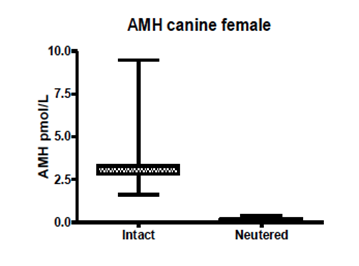Anti‑Müllerian Hormone (AMH) as a means of differentiating neutered and intact dogs and cats
Anti-Müllerian Hormone is a hormone involved in gender differentiation in the developing embryo. In sexually mature dogs it is produced by the granulosa cells of ovarian follicles and in the Sertoli cells of the testicles. AMH levels markedly decline following neutering. Single measurement of AMH is therefore highly effective in differentiating between sexually intact and neutered dogs of both sexes. AMH is also useful in identifying cases of ovarian remnant syndrome and cryptorchidism. The test is only suitable for animals over 6 months and repeat testing may be needed for animals between 6-12 months.

Sample:
3mL of blood in a plain tube.
Samples should reach the lab within 3 days of collection as AMH concentrations gradually increase with sample aging.
Turnaround time:
3-5 days. Testing is only performed Monday to Wednesday.
Interpretation: The reference intervals in neutered animals are:
Females: < 0.6 pmol/L
Males: < 0.7 pmol/L
Reference:
Measurement of serum anti‑Mullerian hormone concentration in female dogs and cats before and after ovariohysterectomy. Journal of veterinary Diagnostic Investigation 23(3) 524-‐‑527.